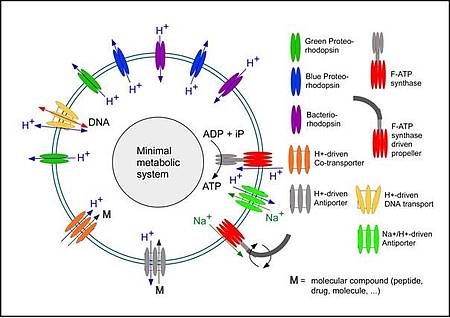NANOCELL
Scientific Goal:
The mission of NANOCELL is to engineer biomimetic molecular machineries of the cell as building blocks that can be robustly and flexibly assembled to nanocells with controllable functionality not found in nature. To approach this goal, we will take nature’s cellular machineries apart and explore their potential to reconstitute them in new ways. The synthetic ‘NANOCELL’ resembling a molecular factory is one strong vision that drives the project. In its first step NANOCELL will master the control of the following biomolecular machines developed by nature, (i) F1Fo-ATP synthases, (ii) ATP-driven nucleic acid translocating machines, (iii) ATP synthase based propellers, (iv) proton-driven drug, solute and peptide transporters, and (v) spectrally tuned light-driven proton pumps.
Most of these machines have in common that either their structure and mechanism and/or their function have been characterized to unprecedented accuracy very recently, which bears the chance to move on now to this engineering approach. From a synthetic biology approach we will reconstitute these machines into stable synthetic vesicles. Proton gradients that either power biomolecular machines will be generated by spectrally tunable light-driven proton pumps bacterio- and proteorhodopsins.
Short-term goals are to develop strategies to manipulate and engineer the individual biomolecular machines to be used as building blocks to establish a NANOCELL. Procedures for their reconstitution into synthetic vesicles building the frame of the future NANOCELL will be established. In the long-term, we intend to use several of these engineered building blocks to create complex NANOCELLS.
With this approach of establishing engineered building blocks we can functionalize NANOCELLS to generate, for example, a proton-gradient that guides the uptake or release of drugs, peptides, DNA, or solutes or to physically move the NANOCELL. It is also thought to spectrally tune proton-gradients to synthesize ATP used for minimal metabolic processes within the NANOCELL.
Project Leader:
Professor Daniel Müller, University of Technology Dresden, Germany
Principal Investigators:
Professor Helmut Grubmüller, Max Planck Institute for Biophysical Chemsitry, Göttingen, Germany
Dr Thomas Meier, Max Planck Institute of Biophysics, Frankfurt am Main, Germany
Professor Richard Michael Berry, University of Oxford, United Kingdom
Professor Wolfgang Meier, University of Basel, Switzerland
Professor Dimitros Fotiadis, University of Berna, Switzerland
Professor Sven Panke, ETH Zürich, Switzerland
Associated Partner:
Professor José Carrascosa, CSIC, Madrid, Spain



